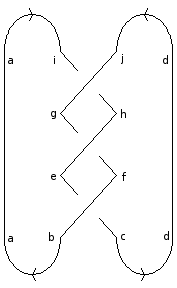R-Matrix Invariants
KnotTheory` can compute knot and link invariants associated with matrix solutions of the Yang-Baxter equation, using the program REngine:
(For In[1] see Setup)
In more detail, let be a free module of finite rank over a commutative ring, and let be invertible. Further, let there be invertible endomorphisms ; these correspond to McupL, McupR, McapL, and McapR respectively. Fixing a basis of V, we can regard all of these endomorphisms as matrices.
The following notation is useful: for , refers to the element of R in row row and column .
For an oriented knot or link , REngine returns the product , which is computed as follows:
- Find a Morse link presentation of such that it is composed only of crossings of the
X[k, Over/Under, Down, Down]variety; this is accomplished by adding caps and cups where necessary. - Label the edges in between events in the Morse link presentation of .
- Associate each event with one of the matrices as shown, with the indices given by the labelling:
- Define as the result of taking the product of the matrices associated with the elements of K, and summing over repeated indices; each sum runs from 1 to .
As an example, let K be the trefoil as shown, with the chosen axis upwards, and the strands going down through all the crossings. Then
where the summation is carried out on all the indices a through i, each ranging from 1 to n.
Determining that is actually an invariant is simply a matter of checking the equality of the outcomes of Reidemeister moves in various configurations and orientations, as well as a few 'topological' moves. Note that REngine does not perform any checks; the utility TestRMatrix does the tests required to determine regular isotopy.












